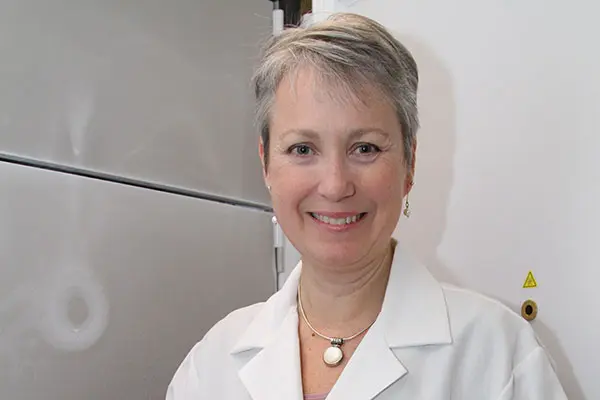Under the Lens: Containing an Opportunistic Pathogen Can Improve the Health of Cystic Fibrosis Patients

04/07/2020
By Edwin L. Aguirre
Prof. Susanna K. Remold, the new chair of the Department of Biological Sciences, has been working to unravel an ecological mystery that could help improve the lives of people with diseases such as cystic fibrosis. One focus of her research is Pseudomonas aeruginosa, an opportunistic pathogen that is a major cause of serious infection in patients with underlying medical conditions or compromised immune systems. Remold was an associate professor of biology at the University of Louisville and a visiting program director for the National Science Foundation (NSF) before joining the faculty at UMass Lowell in 2019. Here, she shares some insight into her work.
Q. Why did you choose Pseudomonas aeruginosa as the subject of your research?
A. This bacterium has been described in biomedical literature as being ubiquitous and common in the environment. My background is in ecology and evolutionary biology, where a central focus is understanding the diversity of life. If it were truly possible to be both common and ubiquitous, why would there be biological diversity? So I thought that there must be something more going on with P. aeruginosa that is yet to be discovered.
Q. According to the Cystic Fibrosis Foundation, about 30,000 people in the United States are living with cystic fibrosis (CF), a genetic disorder that affects the lungs and other organs. And there’s no cure for the disease. How can your research help patients with CF?
A. My research aims to help people understand how they can avoid exposure to P. aeruginosa. It’s known that exposure increases the likelihood of infection and that chronic infection decreases lung function, which then shortens a person’s lifespan. I’m particularly interested in studying homes because I want to intercept exposure in the area where people, especially children, spend the most time.
Q. You and your team of student researchers took about 11,000 swabs of 15 homes in Louisville, Ky. What was your most surprising finding?
A. Although P. aeruginosa has been described as being everywhere and that therefore, it’s hard to avoid getting exposed to it, what our study actually discovered is that it’s relatively difficult to find this microorganism in a typical household. We found them almost exclusively in drains—in the kitchen and bathroom sinks, shower stalls and bathtubs. We don’t know why this is the case, but this is where we found the highest concentration. The physical conditions inside the drain could be one reason, but there can be other reasons that we need to study further.
Q. What can people do to protect themselves from P. aeruginosa?
A. We sampled only the first inch or so inside the drain—the “splash zone,” where the water drains and splashes up and sprays aerosol droplets containing the bacterium into the air that get inhaled by people. P. aeruginosa is a very hardy microbe, so getting rid of it is not easy, especially in a hospital setting. Disinfecting the sink regularly with bleach solution would help. Bleach gel could also be used to coat the drain and garbage disposal to slow down the regrowth of the bacterium. In fact, the Cystic Fibrosis Foundation has changed its recommendations for infection control and prevention to include targeted cleaning of drains, citing our research and some other similar studies.
Q. Who else could benefit from your study?
A. Anybody with compromised immune systems or respiratory problems such as asthma or COPD has the potential to benefit. If you have a condition that predisposes you to infection, and that infection is then going to decrease your quality of life or threaten your life, then knowing how to avoid infection would be valuable.
Q. What made you decide to come to UMass Lowell?
A. Two reasons. First, it’s the amazing hands-on experience that biology students get at UMass Lowell, and I’m really excited to be able to contribute to making this possible. Second, it’s the opportunity to help students, postdocs and faculty early in their careers to develop as the next generation of biology scientists and researchers and to build interdisciplinary interactions and collaborations. UML students, even in their undergraduate years, do actual research and get papers published in refereed journals. They have access to lab courses and research opportunities where they gain hands-on skills that students at many universities don’t get.
Q. What other research projects do you have underway?
A. One area of study that I’m investigating is bacterial weapons, called bacteriocins. These are proteins secreted by bacteria of one strain that target and kill closely related bacteria. I’m trying to understand how these killing interactions help some P. aeruginosa to keep out competing bacteria that might otherwise invade and colonize the same habitat. Another project that I’m pursuing is to find out if my large collection of P. aeruginosa strains might have some that can help in the bioremediation of a group of environmental toxins called PFAS. Although PFAS are very resistant to biodegradation, there’s a report published of a Pseudomonas strain being able to break down a PFAS compound. I’m curious whether household Pseudomonas might be able to break down PFAS too, and am planning on screening my collection of strains to find out.
